MATH INSTRUCTION + EDTECH TOOLS = SUCCESS
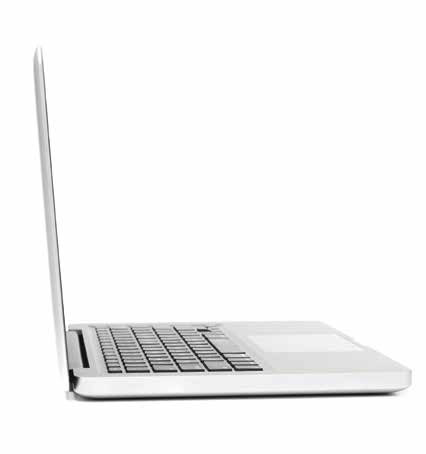
As test scores rise and engagement increases, schools are beginning to see the incalculable benefits of implementing digital curriculum and resources for math instruction. District and school leaders are using data to make strategic decisions, teachers are able to respond to students’ individual needs, and students are employing higher-order critical thinking and reasoning skills—not just to arrive at the right answers, but to gain a deeper understanding of the concepts.
A SECOND-GRADE TECH EXPERT DECIDES MATH IS IMPORTANT, TOO
Students in Julie Spaite’s second-grade class at Granger Elementary School in the Highland (OH) Local School District enjoy lots of tech-rich learning opportunities using Chromebooks and various digital curricula. But for one quiet, less-than-confident, average math student, transitioning to a digital platform meant something more.
When the class discovered that this student “had a knack for problem-solving tech glitches … He quickly became the go-to student” for those who needed assistance. “Yes,” Spaite says, “at first it was just, ‘can you help me with this?’” But there was a shift. He “was in his comfort zone when surrounded with technology” and Spaite watched his confidence blossom and his peer interactions develop. He also became increasingly engaged in learning the content during math lessons. “He wanted to completely understand the math so when students asked for tech help, he could not only help with technology, he could also help with the math.” From academics to social skills to his attitude towards learning, to say that this second grader “evolved is an understatement,” Spaite says.
NURTURING ENGAGEMENT
Two Granger Elementary students work together to generate subtraction strategies to solve computation-based problems. While digital curricula for elementary students need to be engaging and developmentally appropriate, in addition to solidly supporting content standards, Spaite emphasizes that “It’s not just about the flashy graphics and characters. The practice activities must be richly laced with mathematical vocabulary and thinking.” She also looks for “activities that will allow for the students to experience productive struggle in order to expand their conceptual understanding of the topic at hand.”
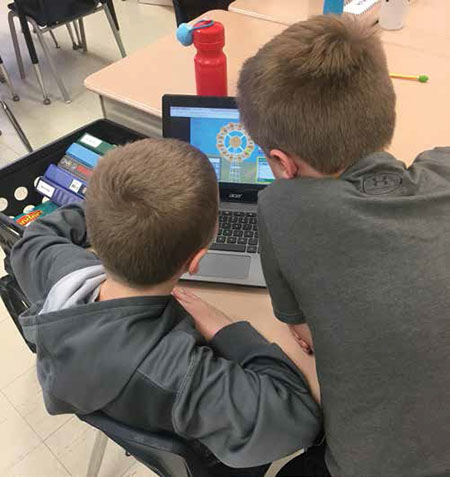
McGraw-Hill Education’s Everyday Mathematics 4 provides this kind of challenge for her students in an all-inclusive program with online activities, reference book, interactive etools, games, tutorial videos, assessments, and more.
Tools and ideas to transform education. Sign up below.
Just as important as the tools, though, is the well-managed, well-organized classroom environment in which digital learning takes place. Students “will instantly pick up on a teacher’s attitude towards technology”—and its challenges. Spaite says it’s a win-win when teachers involve students in problem-solving when issues arise. And when students are asked to explore and become the class “experts” on a digital tool, “You as the teacher will learn so much from them and won’t have to invest hours of your own time exploring each one. Again, it comes back to empowering students to take ownership of their learning and digital experiences.”
NATIVE COMMUNICATION
A Granger Elementary student constructs a trapezoid to demonstrate understanding of the 2D shape’s attributes. Spaite observes this sense of empowerment in her students as they take responsibility for their devices and use them “to manipulate math tools, respond to reasoning prompts, or solve computation-based problems.” They’re “more alive,” she says, as they interact with the lesson.
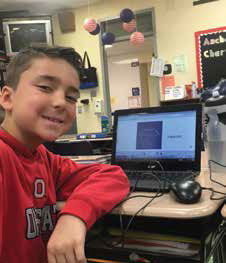
On another level, though, digital learning for today’s young students is about communication in their native language. Because they communicate through technology and “their world exists within the confines of technology … completing math activities and submitting them online is just another way that they communicate through technology,” Spaite says. This goes hand in hand, she says, with increased fluidity of typing skills “even at this young age.” With daily computer time, she says, “we are sneaking in keyboarding practice.”
Spaite sees the skills they’re learning in math carrying through into students’ written expression as well. Younger students are being asked more frequently “to reason, justify, and defend their mathematical thinking and strategies.” The relationship between technology, communication, and math is symbiotic—the more familiar students are “with navigating through various types of questions, problems, and written responses, the more they can focus on the [mathematical] content at hand.”
TOOLS THEY USE
GRANGER ELEMENTARY
► Chromebooks
► EduTyping
► i-Ready Math and Reading
► iPads
► Lexia Reading
► McGraw-Hill Education’s Everyday Mathematics 4
► Scholastic News
► Time for Kids
► TumbleBooks
TAKING THE BEWILDERMENT OUT OF MATH
David Keech focuses on teachable moments and hands-on, project-based learning for students at all levels. At Wisconsin Rapids Area Middle School (WRAMS), math interventionist David Keech focuses on teachable moments and hands-on, project-based learning for students at all levels. “I want my students to be able to see the connections with math and their world, with math and other subjects,” he says. “If a student wants to write a song to demonstrate mastery of a particular objective, or create a piece of artwork, I welcome those interpretations … my goal has always been to take some of the bewilderment out of math.”
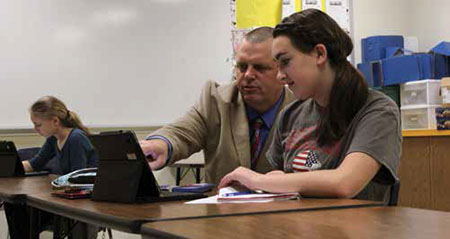
In his position, Keech, an experienced classroom teacher and self-proclaimed math geek, balances planning intervention instruction with teachers and the district coordinator with teaching four different grade levels of math each day—from Tier 2 and Tier 3 interventions to gifted students. The district’s partnership with Renaissance helps him to be more effective as he identifies interventions and creates opportunities for differentiating instruction for WRAMS’ 700 students.
With Renaissance Accelerated Math, students are able to access their assignments and work at their own pace to master each standard. Educators can use Accelerated Math to fill in necessary background for concepts or skills students are struggling with, or frontload information to prepare them for what they’ll be learning next. Peer-to-peer learning opportunities are also important. “When you give a group of students the same objectives, it’s a great opportunity for them to work with one another and help each other gain confidence,” Keech says.
PRODUCTIVE STRUGGLE
But, crucially, students are also able to learn from their “productive struggle.” “If they make mistakes, it’s a teachable moment—they’re able to see the steps that they took to get to an incorrect answer, and after a bit of one-on-one work, they try again,” Keech says.
And this kind of problem-solving is an important step in taking the bewilderment out of math, because it leads students to think about the bigger picture, the reasoning behind a math concept—not just what the right answer is. “Students want to know why they’re learning what they’re learning,” he says. “It helps students to know what the target is for them—it makes learning more inclusive and less abstract.”
PRACTICE, PRACTICE, PRACTICE
Renaissance Star Math, which WRAMS uses as an interim assessment three times a year, together with standardized state test scores, attendance, and teacher observations, helps provide a picture of the needs and progress of the whole student as well as of the student body as a whole. This data enables Keech and staff to make informed and effective programming decisions.
Keech attributes the growth he’s beginning to see at WRAMS, as well as the growth he’s witnessed using Accelerated Math in his classroom previously, to the all-important discipline of math practice in the classroom—for both student and teacher. “Using the program to differentiate instruction to the degree that I did as a sixth-grade teacher and now do in this new role required me to learn about the program in depth, to utilize it to its fullest, and it took a great deal of work. … it would have been a disservice to my students to say, ‘Okay, sit at your desks and take out your math books because you’re all going to learn the same thing.’ It helped me reach for something higher—for my students and also for me as their teacher.”
TOOLS THEY USE
WRAMS
► Renaissance Accelerated Math
► Renaissance Star Math
A FLEXIBLE, SUCCESSFUL LEARNING CURVE
PGA elementary students engrossed in a hands-on learning activity on campus. At Poudre School District Global Academy (PGA) in Fort Collins (CO), dedicated educators, a hybrid learning model, parental involvement, plus quality online curriculum are adding up to great success for students. PGA began in 2009 as a fully online K–12 school, but in 2014 the school moved to a unique blended learning program. Students now spend two days a week in school and three days a week at home completing online courses. The diverse student body includes those who were struggling in traditional schools as well as advanced and accelerated students.
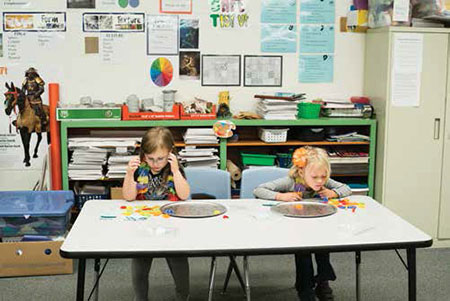
On the NWEA assessment measuring growth in math from fall 2014 to spring 2015, PGA elementary-school students averaged 140% of typical growth and middle-school students averaged 242% growth. On the spring 2015 math PARCC assessment, PGA students out-performed state averages on seven out of nine assessments. Founding principal Heather Hiebsch attributes these achievements to the dynamic and flexible group and individual mentoring that teachers provide, to the critical role of parent/guardian learning coaches, who complete a training program developed by PGA, and to FuelEd’s excellent curriculum resources.
AN INTEGRATED AND SYNERGISTIC SYSTEM
Flexibility is key to the success of PGA’s partnership with FuelEd. “FuelEd isn’t an expert in what my teacher needs in a given course, in terms of relationships, structure, order, flow,” says Hiebsch. Neither are PGA teachers “necessarily experts at creating media-rich content, like video and graphics. Each does what they do best and they work together in the most effective way.”
FuelEd and its content partner, K12 Inc., supply most of the online courses and related content, which students can access 24/7 for anytime, anywhere learning. PGA teachers collaborate to customize the online content and develop original instruction, and they use the actionable data FuelEd provides to personalize learning for each student. While PGA teachers facilitate all core courses, both online and on campus, FuelEd provides teachers for world language courses and electives as needed.
All students have devices (tablets and laptops) to use at school, and middle-and high-school students can take their devices home. Students take online teacher-led courses at home, and in the campus learning environment, face-to-face instruction and online learning combine into an integrated and synergistic system.
THE BEST OF BOTH WORLDS
High-school students at PGA engaged in an on-campus lab experience. Sixth through eighth graders use some content from the FuelEd Middle School Course Catalog in combination with other district-approved and adopted programs. For grades 9–12, PGA uses FuelEd’s Full-Time School (FTS) Comprehensive Program with its multiple academic levels—core, comprehensive, honors and Advanced Placement, remediation, and credit recovery—and 75 STEM courses. High-school students also take some online courses developed by teachers in the district. The district’s Blackboard LMS hosts both the FuelEd and in-house course content.
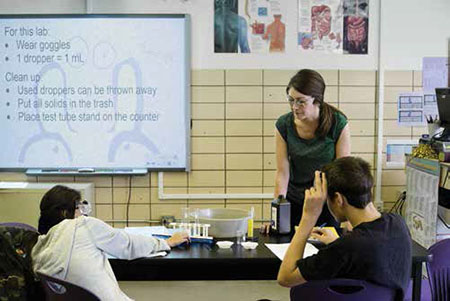
Staff, students, and families concur that PGA’s motto, “global education—local community,” reflects the school’s commitment to building strong relationships balanced with a rigorous and personalized curriculum.
While PGA has received numerous national awards, including the national 2014 Transformation Award, the most important validation comes from the students. PGA students are excited about their academic growth and enjoy monitoring their performance data and progress using K12’s Online School (OLS) course management tool. They also enjoy the flexibility of learning at their own pace and growing into responsible, independent learners who control both the schedule and style of their own learning.
TOOLS THEY USE
PGA
► Blackboard
► FuelEd
► K12
► Laptops
► Tablets
BLENDED, IMMERSIVE, ENGAGING
Students in the Sanford Middle School math lab use Think Through Math (now Imagine Math). Technology is integral to the learning experience at Sanford Middle School (SMS), a STEM magnet in Seminole County (FL) Public Schools. Principal Randy Shuler says that, over the past two years, two advances in technology in particular have permeated their instructional focus: blended learning and immersive technology.
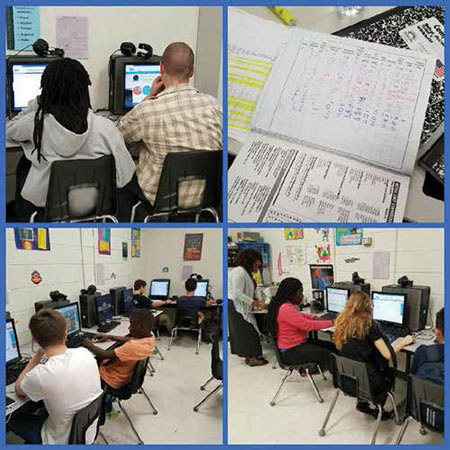
The SMS math lab, which is divided into three areas, features “a blended rotational model that provides a targeted approach,” says Shuler. The flexible station rotation benefits both non-proficient, at-risk students as well as gifted and advanced students.
In the computer area, students work with Think Through Math (now Imagine Math), which gives them guided practice in areas where they have deficiencies. “If a student struggles, the program allows students to get support from an online tutor,” Shuler says, “so students are never stuck and given an excuse to give up.” And the program’s robust data management system enables teachers to create rotations for the math lab’s other two areas. In the second area, groups of 10 to 15 students engage in hands-on learning using manipulatives and real-world exercises. In the third area, a teacher works one-on-one with three to four students on specific skills.
Students today spend “an exorbitant amount of time” playing online games, Shuler says, and “the games they gravitate to are the ones that put them in the middle of the action as if they were right there in the environment. Educational technology is beginning to shift in that direction as well.” To give students immersive learning experiences, SMS uses programs and devices including zSpace, VR viewers, and Google Expeditions. “One minute you could be dissecting a heart,” Shuler says, “and the next standing on the Great Wall of China.”
How has all of this technology affected learning? Shuler has witnessed “a tremendous difference” in student interest and engagement. Walk into any class, he says, and while students still “may not like math, they are focused on learning and putting forth greater effort. Grades and test scores reflect this positive transition.”
KEY QUESTIONS
Sanford Middle School students use zSpace. Shuler and his team ask the following questions when evaluating new edtech products to integrate into their classes:
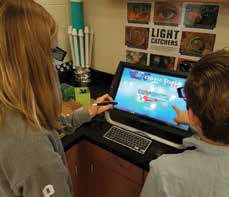
Will it be engaging to our learners?
Does it allow for mastery of the standards and the appropriate cognitive level?
Can it be used to differentiate learning or individualize instruction in a blended learning environment?
Does it provide an immersive or real-world experience?
JUMPING LEVELS
The success story of one student encapsulates the many benefits of the blended learning approach. In an intensive math class last year, this student worked through modules both at school and at home, with one-on-one support from his teacher in areas where he struggled. “This student jumped two levels on his standardized testing and is enrolled in advanced courses this year,” Shuler says. “He has been a great success and huge motivator for those students who were with him last year in intensive math.”
TOOLS THEY USE
SANFORD MIDDLE SCHOOL
► zSpace
► Think Through Math (now Imagine Math)
► Google Expeditions
DIRECT CORRELATIONS: DIGITAL CURRICULUM AND STUDENT GROWTH
A fifth-grade Prairie Trail student uses Go Formative to complete a test. At Prairie Trail School in Gurnee (IL) School District 56, students “utilize technology in every class and subject area” says principal Kevin Simmons. Many different edtech tools, including 1:1 iPads, help teachers to differentiate and personalize learning and “support student and teacher innovation and creativity.”
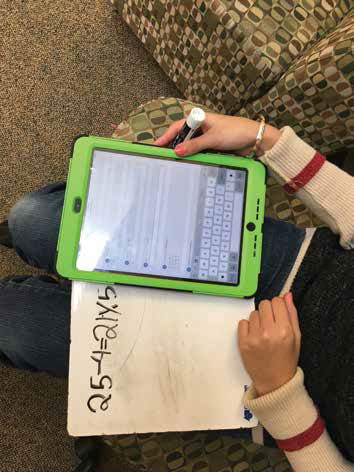
Over the past three to four years, the school’s increased use of digital math curriculum “has coincided with an increase in the percentage of students who meet or exceed NWEA growth projections,” says Simmons. By any standard, these gains are significant—from 55–58 percent classrooms, between 90 and 100 percent of students have met or exceeded those growth projections.
Far from resting on these impressive laurels, however, Simmons and his team have been doing their own math homework to take full advantage of what the numbers can tell them about helping both teachers and students to continue to grow.
DATA: AN ANNUAL GROWTH CYCLE
For mathematics, Simmons and his team triangulate performance data from NWEA MAP tests, ST Math, and AIMSweb “to support teachers’ efforts to evaluate the impact of instructional decisions” and to gauge the impact of curriculum, instruction, and intervention programs for all students.
Fall NWEA MAP test scores help them assess growth projections, set goals, and develop instructional plans and placement options for each student in each classroom. Simmons notes that this data also reveals how students have grown and received support (or not) over the summer. ST Math data, Simmons says, “is used to track student progress on conceptual understanding,” and “AIMSweb data is used as a progress monitoring tool for students who are receiving academic interventions.” The data from both of these tools, Simmons says, “allows us to monitor student progress on a more frequent basis than is possible with PARCC or the NWEA Map test.”
With winter data, Simmons says, “we can determine which students have made enough growth to meet their mid-year projection.” They then work with teachers and School Improvement teams to make necessary adjustments in instruction, programming, and even the ordering of curriculum. They set new goals for students who have met or exceeded targets, where appropriate, in addition to finding strategies to give extra support to those who need it.
Spring data enables the team to reflect, assess, revise, and determine PD needs and staff and resource allocation for the following year.
FROM INATTENTIVE TO THRILLED—IN ONE WEEK
A Prairie Trail teacher encourages fifth-grade students to chart their progress on ST Math. How does this big-picture data analysis drill down to the classroom? One third-grade teacher introduced ST Math to a student who lacked confidence and tuned out during whole-group instruction in math. Though the game-like structure helped the student’s focus improve, she found the tasks tricky. So student and teacher worked together for a few days on one particular task. The student kept notes on what she’d done and verbalized what she could try next. The teacher affirmed her “grit” for persevering and saw her begin to engage.
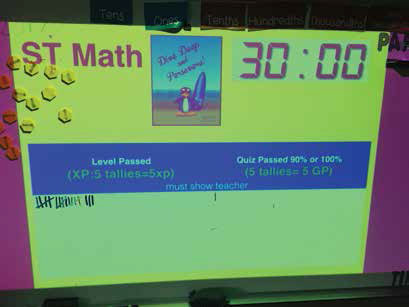
When she finally passed, the student was thrilled. The teacher contacted her mother, who was excited and shared that her daughter had been trying ST Math at home too. This student has continued to progress, moving her game piece across the giant ST Math game board. The teacher attributes this transformation in focus and motivation to “the instant feedback from ST Math, coupled with personalized instruction … As a teacher, this was really cool to see.”
TOOLS THEY USE
PRAIRIE TRAIL
► AIMSweb
► Apple laptops
► Front Row
► iPads
► IXL
► Learning Farm
VETTING TOOLS
As a large, innovative district, Gurnee School District 56 uses many different edtech tools and has also partnered with companies to provide feedback on products that are still in development. Kevin Simmons, principal of Prairie Trail School, identifies “the sheer volume of products available” as a challenge.
Districts need, therefore, to determine “which products meet what needs and analyze products for overlap, redundancy, and cost versus reward” in addition to understanding the features, data, and curriculum support that each product provides. Helping teachers prioritize and learn to utilize a few resources well and “resist the temptation to try to use all of them at once” is also important, Simmons says. He advises schools and districts to “continually examine the protocols … to vet programs” and develop “a shared understanding of what each tool does and does not do, and how the data generated from each is best put to use.” Doing this well, he says, empowers “teachers to feel, see, and understand the coherence of your programming and of your curriculum, understand and embrace the choices that are being made, and stay resilient in the face of a culture that embraces continuous improvement.”
